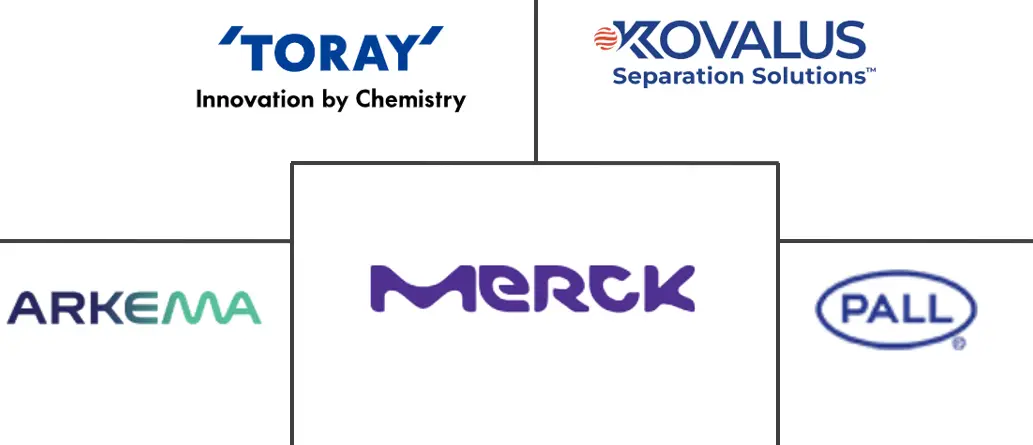PVDF Membrane Market Size and Share
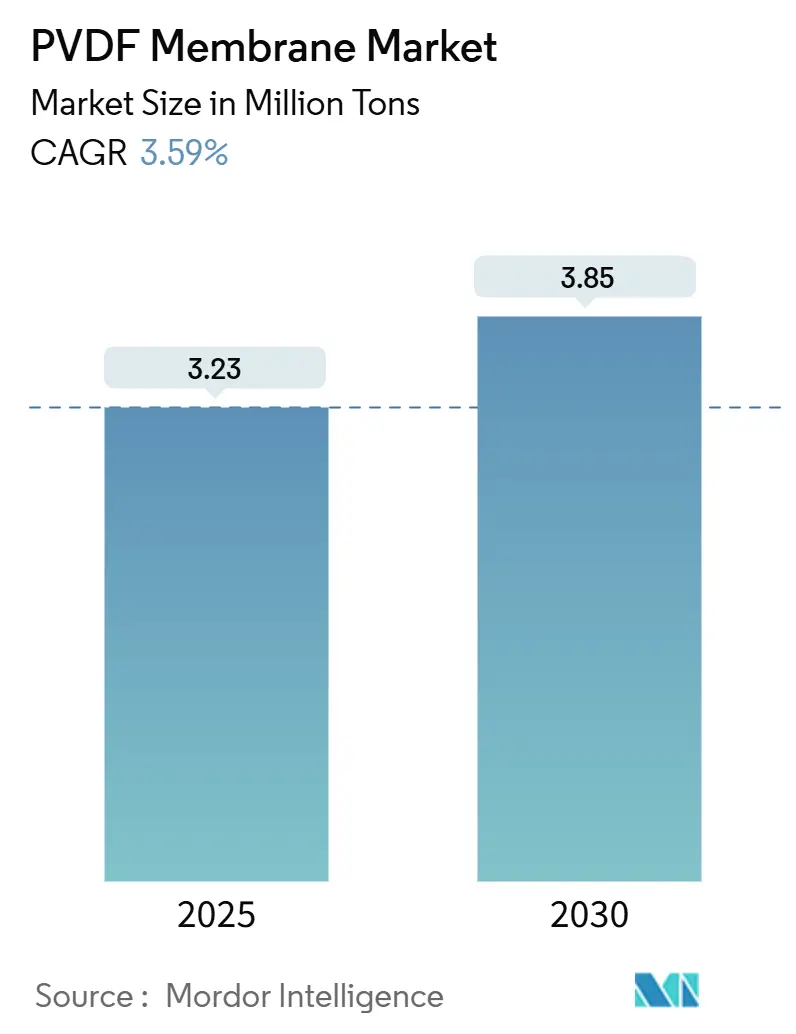
PVDF Membrane Market Analysis by Mordor Intelligence
The PVDF membrane market reached 3.23 million tons in 2025 and is forecast to advance to 3.85 million tons by 2030, translating to a 3.59% CAGR. This solid expansion reflects rising adoption of high-performance membranes across bioprocessing, industrial filtration, and emerging water-treatment systems. Continuous bioprocessing, fast-growing single-use process trains, and stricter purity regulations in pharmaceuticals sustain high replacement cycles. Southeast Asian capacity additions, ongoing lithium-ion battery separator projects, and growing investment in decentralized water solutions reinforce demand momentum. Heightened regulatory scrutiny of PFAS polymers is simultaneously spurring research into PFAS-free chemistries, yet the performance gap delays large-scale substitution, preserving near-term demand for incumbent PVDF grades.
Key Report Takeaways
- By membrane type, hydrophilic products led with 59.25% revenue share in 2024; the same segment is projected to expand at a 3.85% CAGR through 2030.
- By technology, microfiltration held 41.68% of the PVDF membrane market share in 2024, while nanofiltration is set to register the highest CAGR at 4.02% to 2030.
- By application, filtration accounted for 38.22% of the PVDF membrane market size in 2024 and is advancing at a 4.87% CAGR through 2030.
- By end-user industry, the biopharmaceutical sector commanded 44.67% share of the PVDF membrane market size in 2024 and is forecast to grow at a 4.64% CAGR.
- By geography, Asia-Pacific dominated with 56.18% revenue share in 2024; the region also shows the fastest growth at a 4.72% CAGR through 2030.
Global PVDF Membrane Market Trends and Insights
Driver Impact Analysis
| Drivers | (~) % Impact on CAGR Forecast | Geographic Relevance | Impact Timeline |
|---|---|---|---|
| Rapid Growth of Bioprocessing Demand | +1.2% | Global, with concentration in North America and EU | Medium term (2-4 years) |
| High Demand for Industrial Filtration Materials | +0.8% | APAC core, spill-over to MEA | Long term (≥ 4 years) |
| Rising Utilization in Medical and Diagnostic Devices | +0.6% | North America and EU, expanding to APAC | Short term (≤ 2 years) |
| Continuous Expansion of Biotechnology and Pharmaceutical Sector | +0.7% | Global | Long term (≥ 4 years) |
| Growing Demand for Wastewater Treatment Applications | +0.4% | APAC and MEA primarily | Medium term (2-4 years) |
| Source: Mordor Intelligence | |||
Rapid Growth of Bioprocessing Demand
Surging biologics pipelines magnify throughput pressures, accelerating the shift from batch to continuous downstream operations that rely on high-flux hydrophilic PVDF filters. Planova FG1, introduced by Asahi Kasei in late 2024, delivers seven-fold higher flux than legacy PVDF grades while preserving 99.999% endotoxin retention, setting new benchmarks for virus removal filters. Regulatory support for continuous manufacturing, combined with the rise of single-use assemblies, lifts replacement frequency, keeping the PVDF membrane market on a steady upward slope. Monoclonal antibody titers above 10 g/L and emerging cell-therapy modalities intensify performance requirements that favor PVDF’s low protein-binding profile. These dynamics underpin the largest incremental tonnage gains through 2030.
High Demand for Industrial Filtration Materials
Stricter discharge norms and cost-driven process intensification in petrochemical, semiconductor, and specialty-chemical sites are amplifying demand for chemically robust membranes. PVDF operates reliably up to 150 °C and resists aggressive solvents, extending uptime in harsh loops where polyethersulfone and cellulose fall short. Asia-Pacific refiners and chemical parks are leading deployments of anti-scaling PVDF modules tailored for calcium- and silica-rich waters, with positive-charge surface treatments lowering downtime by 28% compared with unmodified films. The result is a sustained pull on the PVDF membrane market, especially for large-bore micro- and ultrafiltration cartridges.
Rising Utilization in Medical and Diagnostic Devices
Point-of-care platforms, lateral-flow cassettes, and sterile vent filters favor PVDF for its gamma and autoclave compatibility. Recent hollow-fiber nanofiltration trials removed enveloped and non-enveloped viruses with more than 4-log reductions while accommodating elevated feed concentrations, validating PVDF for next-generation gene-therapy processes. Mechanical robustness enables sub-50 µm thin-film membranes, essential as device makers miniaturize formats for rapid diagnostics. Accelerating adoption in Asia’s expanding diagnostic consumables manufacturing clusters will add short-term volume tailwinds to the PVDF membrane market.
Continuous Expansion of the Biotechnology and Pharmaceutical Sector
Global biologics revenue YoY growth above 11% sustains capital investment in downstream purification lines that universally specify PVDF cartridges for depth, virus, and vent filtration. The pivot toward personalized vaccines and mRNA therapeutics reinforces the need for membranes with low extractables and high chemical inertness, properties inherent to PVDF. Contract development and manufacturing organizations (CDMOs) increasingly insist on multiproduct-validated PVDF skids to maintain scheduling flexibility, broadening the PVDF membrane industry customer base. Digital twin pilots in biologics plants also highlight membrane fouling metrics, giving PVDF’s longer clean-in-place cycles a data-driven endorsement.
Restraint Impact Analysis
| Restraints | (~) % Impact on CAGR Forecast | Geographic Relevance | Impact Timeline |
|---|---|---|---|
| High Cost of PVDF Membranes | -0.4% | Global, particularly price-sensitive markets | Short term (≤ 2 years) |
| Membrane fouling in high-fat Food and Beverage streams | -0.2% | Global Food and Beverage processing regions | Medium term (2-4 years) |
| ESG scrutiny on fluorinated polymers disposal | -0.3% | EU primarily, expanding globally | Long term (≥ 4 years) |
| Source: Mordor Intelligence | |||
High Cost of PVDF Membranes
Complex fluoromonomer synthesis, specialized solvent-casting, and stringent cleanroom assembly push PVDF film prices well above PES or nylon. In high-volume municipal plants, procurement managers still favor lower-cost polymers unless process chemistry or temperature extremes render substitutions impossible. Hybrid PVDF-blend membranes under early validation show promise to lower the cost per m², but widespread regulatory acceptance remains two to three years away, tempering near-term demand growth.
ESG Scrutiny on Fluorinated Polymers Disposal
European regulators are advancing broad PFAS restrictions under REACH that encompass PVDF end-of-life treatment, compelling producers to develop take-back or recycling pathways. Pressure is spreading to North America through state-level proposals, elevating compliance costs and increasing documentation burdens for exporters[1]European Environment Agency, “PFAS Polymers in Focus: Supporting Europe’s Zero Pollution, Low-Carbon and Circular Economy Ambitions,” eea.europa.eu. Some pharma contractors have launched assessments of PFAS-free alternatives, yet performance gaps in solvent resistance and protein-binding persist. The resulting uncertainty may delay capital spending in facilities that fear retrofit liabilities, applying a modest drag on the PVDF membrane market trajectory over the long term.
Segment Analysis
By Membrane Type: Hydrophilic Dominance Drives Performance
Hydrophilic grades led with 59.25% of 2024 revenue and contributed the highest incremental tonnage, reinforcing the PVDF membrane market’s emphasis on water-wettable surfaces for biologics and potable-water duties. At a 3.85% CAGR to 2030, hydrophilic variants continue to outpace overall expansion, enabling lower trans-membrane pressures, extending batch runs, and easing post-use cleaning. Advanced plasma-grafting and polyvinyl-alcohol coatings now deliver flux recovery above 92%, outclassing unmodified counterparts that peak near 71%[2]ACS Publications, “Enhancing the Antifouling Properties of PVDF Membrane through Blending and Surface-Grafting Modification Approach,” pubs.acs.org.
Hydrophobic films remain relevant in venting, solvent filtration, and gas-transfer devices, where their inherent water repellence prevents wet-out. They also underpin emerging membrane distillation pilots that recover water from hypersaline brines at energy inputs 15% below thermal systems. The coexistence of both chemistries sustains a balanced offer lineup, but continuous biologics adoption secures the hydrophilic segment’s prime contribution to PVDF membrane market growth.
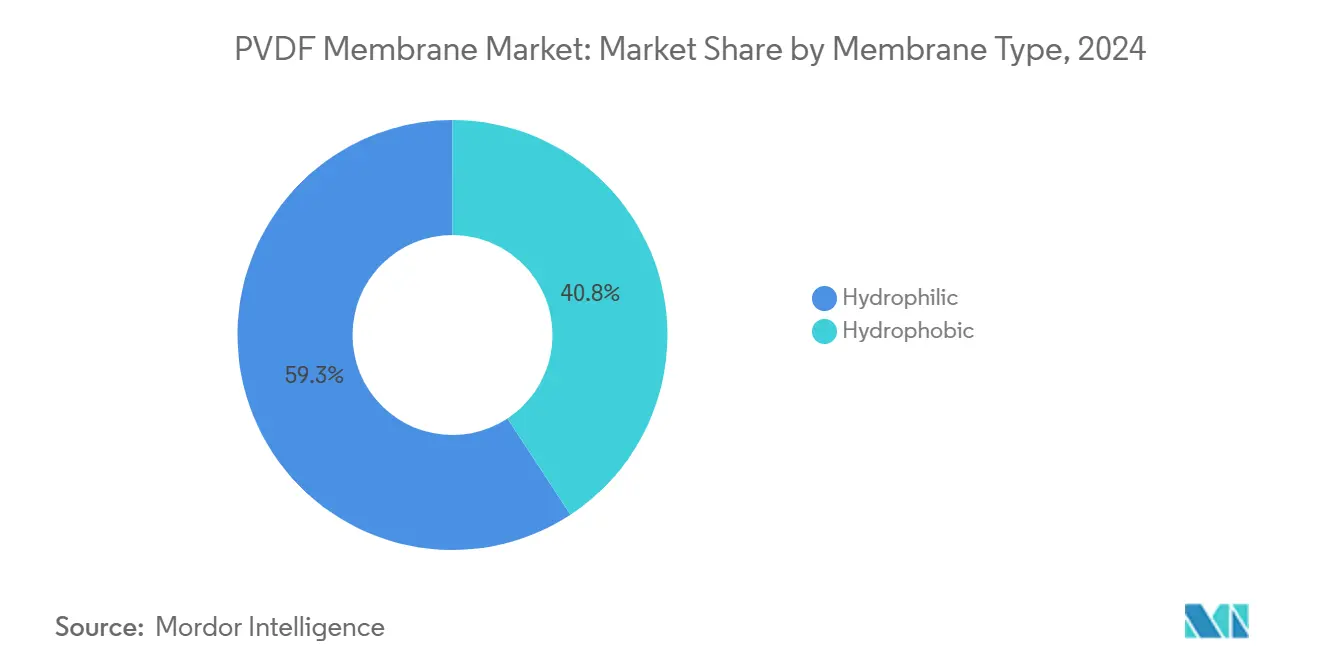
Note: Segment shares of all individual segments available upon report purchase
By Technology: Microfiltration Leadership Faces Nanofiltration Challenge
Microfiltration retained a 41.68% share in 2024, buoyed by entrenched use in cell harvest, utility water, and solvent clarification. Despite maturity, incremental gains stem from larger module formats and anti-scaling coatings that stretch cleaning intervals by 20%. Nanofiltration, although smaller, is the fastest climber at a 4.02% CAGR, driven by viral-clearance protocols and selected water-softening niches. Hollow-fiber designs are attaining more than a 4-log viral reduction with a lower footprint, bolstering customer confidence.
Ultrafiltration and membrane distillation round out the landscape, addressing mid-range separations and high-salinity streams, respectively. Convergence trends, such as asymmetrical pore structures that integrate micro- and nano-layers, are emerging to tackle broader solute spectra in a single pass. Such hybridization maintains technology vitality and diversifies the PVDF membrane market offer.
By Application: Filtration Supremacy Spans Multiple Industries
Filtration dominated with a 38.22% share in 2024 and is forecast to grow 4.87% annually as regulators tighten contaminant limits across pharma-grade water, fine chemicals, and food and beverage liquids. The PVDF membrane market size for filtration applications is projected to surpass 1,600 tons by 2030, driven by stricter microbial and endotoxin specifications. Blotting and electrophoresis retain niche but steady demand in academic and diagnostic labs, where PVDF’s protein-binding capacity assures crisp band transfer.
By End-user Industry: Biopharmaceutical Sector Drives Innovation
Biopharmaceutical plants accounted for 44.67% of shipments in 2024 and will post the highest volume gains at a 4.64% CAGR, cementing their role as the PVDF membrane market bellwether. Single-use downstream skids consume multiple membrane grades, from depth to virus filters, and replacement cycles align with each batch, raising per-product membrane intensity. Beyond monoclonal antibodies, gene-therapy plasmid and viral-vector lines demand tight endotoxin control, elevating hydrophilic PVDF consumption.
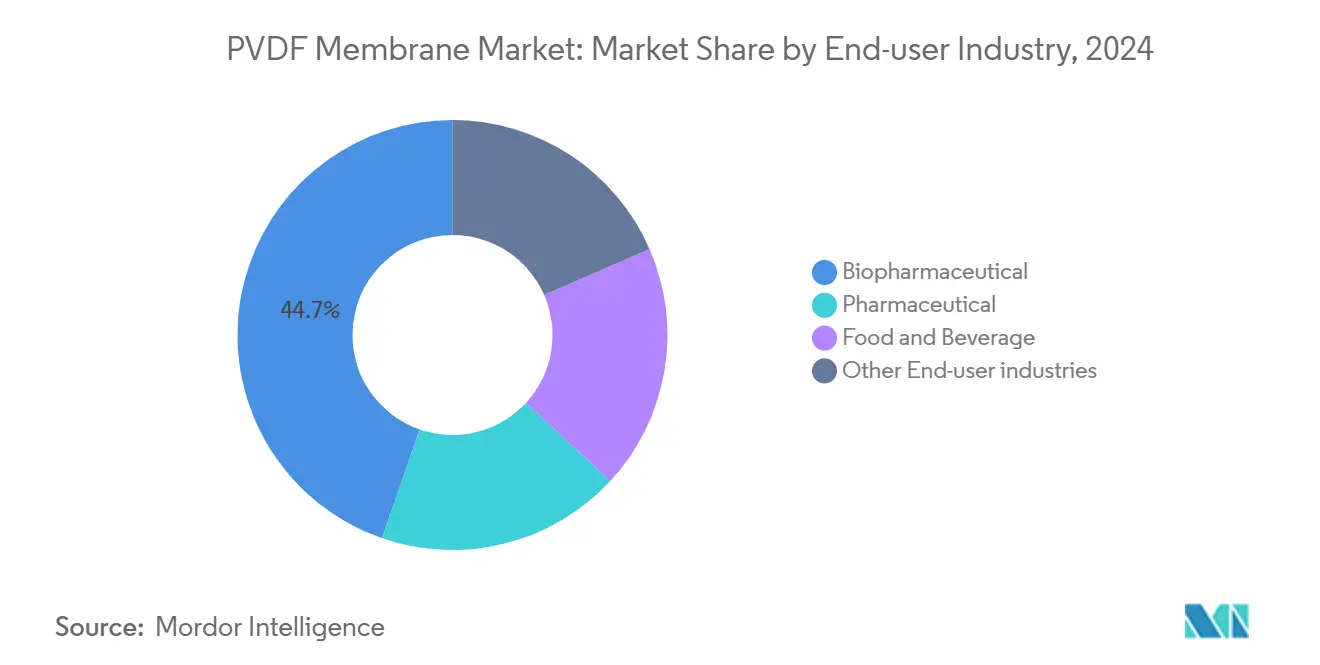
Note: Segment shares of all individual segments available upon report purchase
Geography Analysis
Asia-Pacific, with a 56.18% share in 2024, anchors global production and demand. China’s integrated fluoropolymer supply chain delivers cost advantages, while Japan’s membrane-modification prowess seeds high-value exports. North America leverages deep biologics pipelines, stringent FDA validation protocols, and sustained municipal investment in PFAS removal systems.
Europe balances mature biopharma hubs with tightening PFAS regulation. REACH proposals elevate compliance requirements and drive circular-economy pilots focused on membrane recycling. Meanwhile, South America and the Middle-East, and Africa register double-digit volume growth from power, mining, and seawater desalination projects, incrementally broadening the global PVDF membrane market footprint.
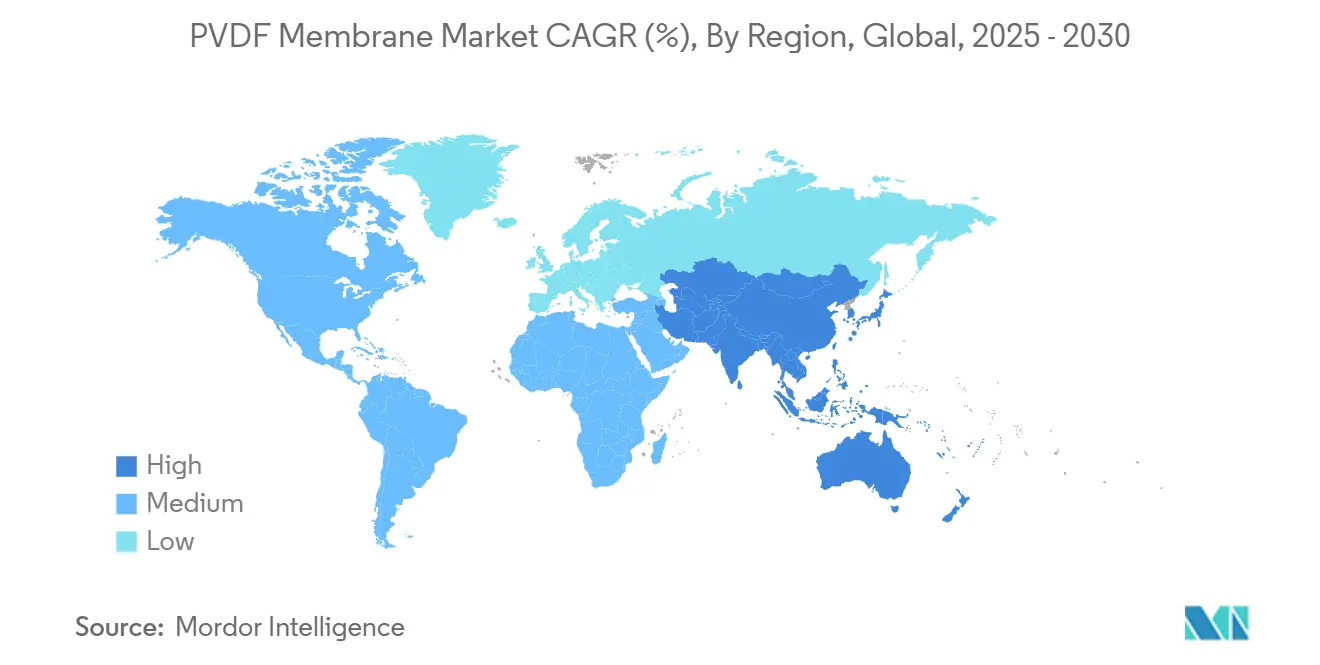
Competitive Landscape
The PVDF membrane market remains moderately fragmented. Vertical integration is deepening as resin suppliers purchase downstream module specialists to secure offtake and margins. Technological differentiation centers on surface modification, coatings, hydrophilic grafting, zwitterionic layers, and anti-scaling additives that raise flux or fouling resistance.
PVDF Membrane Industry Leaders
-
Arkema
-
Merck
-
Pall Corporation (Danaher Corporation)
-
Toray Industries, Inc.
-
Kovalus Separation Solutions
- *Disclaimer: Major Players sorted in no particular order
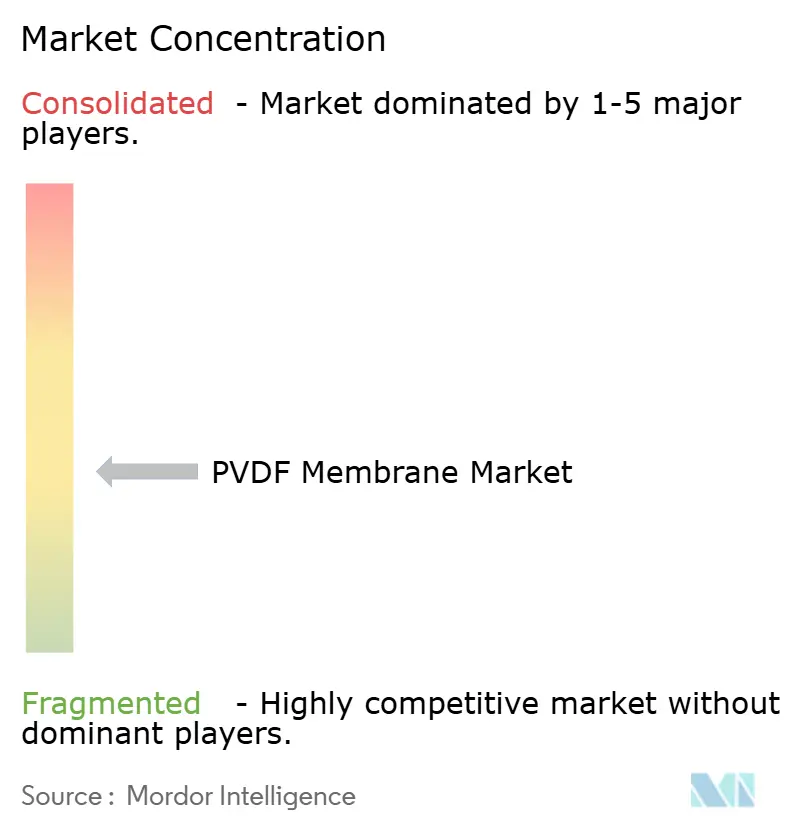
Recent Industry Developments
- May 2024: Asahi Kasei Medical completed a third assembly plant for Planova virus removal filters in Nobeoka, Japan, adding hydrophilic PVDF hollow-fiber capacity.
- July 2023: Arkema and Polymem partnered with Tergys to deploy containerized drinking-water units using Kynar FSF PVDF membranes compliant with French ACS standards.
Research Methodology Framework and Report Scope
Market Definitions and Key Coverage
Our study defines the polyvinylidene difluoride (PVDF) membrane market as the worldwide demand for finished flat-sheet or hollow-fiber membranes made wholly from PVDF resin and supplied in rolls, cassettes, cartridges, or modules for filtration, purification, separation, and blotting across biopharmaceutical, industrial water, food, electronics, and laboratory settings. Mordor Intelligence counts both hydrophilic and hydrophobic grades at original sale and at subsequent replacement.
Scope exclusion: We exclude PVDF resin consumed in battery binders, coatings, pipes, or composite membranes where PVDF represents less than half of the active layer.
Segmentation Overview
- Membrane Type
- Hydrophobic
- Hydrophilic
- Technology
- Microfiltration
- Ultrafiltration
- Nanofiltration
- Other Technologies
- Application
- Filtration
- Blotting
- Separation
- Purification
- Other Applications
- End-user Industry
- Biopharmaceutical
- Pharmaceutical
- Food and Beverage
- Other End-user industries
- Geography
- Asia-Pacific
- China
- Japan
- India
- South Korea
- Rest of Asia-Pacific
- North America
- United States
- Canada
- Mexico
- Europe
- Germany
- United Kingdom
- France
- Italy
- Rest of Europe
- South America
- Brazil
- Argentina
- Rest of South America
- Middle-East and Africa
- Saudi Arabia
- South Africa
- Rest of Middle-East and Africa
- Asia-Pacific
Detailed Research Methodology and Data Validation
Primary Research
Mordor analysts spoke with membrane OEM process engineers, Asian contract water-treatment operators, procurement leads at US biopharma plants, and European distributors. These interviews validated preliminary numbers, filled pricing and replacement-cycle gaps, and refined adoption curves inferred from secondary data.
Desk Research
We began with UN Comtrade shipment codes, United States International Trade Commission tariff tables, and Japan Chemical Fibers Association production yearbooks to map physical flows. Patent family searches on Questel, quarterly filings to the US SEC and Tokyo Stock Exchange, and regulatory notices from the European Chemicals Agency on PFAS informed supply shifts and potential demand restraints. Technical depth came from peer-reviewed work in the Journal of Membrane Science, while Dow Jones Factiva, company press releases, and investor decks clarified pricing and capacity moves. This list is illustrative; many additional public and paid sources underpinned our desk work.
Market-Sizing & Forecasting
A top-down build starts with installed membrane area across water, bioprocessing, and food verticals reconstructed from production and trade records. It then converts it into volume through standard packing densities. Select bottom-up checks, supplier shipment roll-ups and sampled ASP × square-meter calculations, reconcile totals. Key model inputs include membrane replacement interval, average surface per unit of treated fluid, new bioreactor capacity additions, municipal reuse project announcements, and PFAS-phase-out timelines. Multivariate regression blended with scenario analysis projects these drivers to 2030, and gaps in bottom-up estimates are bridged using utilization factors confirmed in primary interviews.
Data Validation & Update Cycle
Outputs undergo triple-layer analyst review, where anomalies are tested against bioprocessing CAPEX trends and quarterly shipment disclosures. Models refresh annually, with interim updates for material events, so clients always receive the latest baseline.
Why Mordor's PVDF Membrane Baseline Stays Trustworthy
Published figures often diverge because providers pick different product mixes, years, and pricing paths.
Our disciplined scope, dynamic price curves, and yearly refresh narrow those gaps for clearer decision making.
Benchmark comparison
| Market Size | Anonymized source | Primary gap driver |
|---|---|---|
| 3.23 million tons (2025) | Mordor Intelligence | - |
| USD 779 million (2022) | Global Consultancy A | Narrow end-use scope, constant ASP, older base year |
| USD 724.53 million (2024) | Research Firm B | Omits blotting demand, fixed replacement rate |
These comparisons show that our balanced, variable-driven framework delivers a transparent, reproducible baseline that decision makers can trust.
Key Questions Answered in the Report
What is the current size of the PVDF membrane market?
The PVDF membrane market reached 3.23 kilotons in 2025 and is projected to climb to 3.85 kilotons by 2030 at a 3.59% CAGR.
Which region leads PVDF membrane consumption?
Asia-Pacific dominates with a 56.18% share in 2024 and is also the fastest-growing region at a 4.72% CAGR through 2030.
Why are hydrophilic PVDF membranes preferred in bioprocessing?
Hydrophilic grades offer higher water permeability, lower protein fouling, and compatibility with single-use continuous processing, giving them 59.25% market share in 2024.
How are PFAS regulations affecting the market?
Proposed European REACH restrictions on fluorinated polymers are driving R&D into PFAS-free alternatives and recycling programs, adding compliance costs but also spurring innovation.
Which application segment is expanding fastest?
Filtration duties hold 38.22% of 2024 revenue and are forecast to grow at 4.87% annually, propelled by tighter purity standards across pharmaceuticals, fine chemicals, and water-treatment plants.
Page last updated on:
